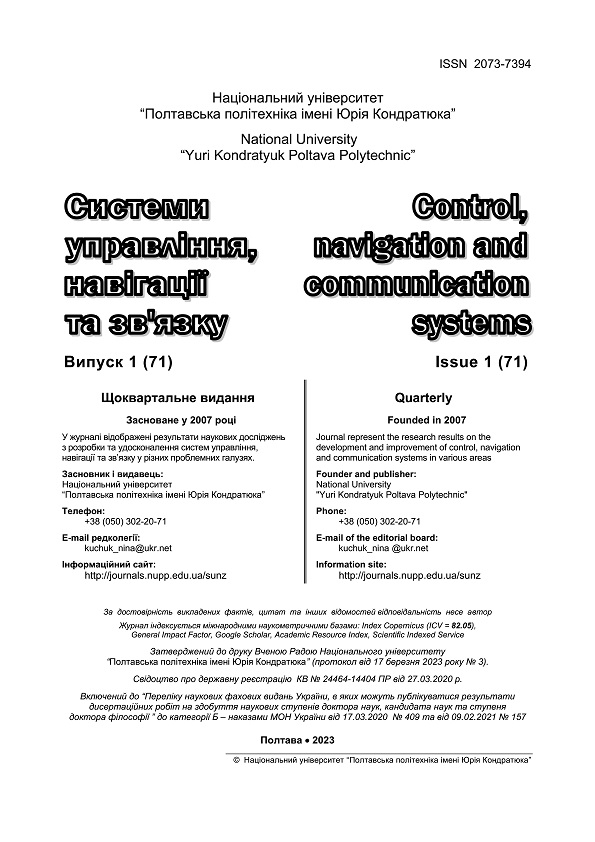КОДУВАННЯ ДЛЯ ЗМЕНШЕННЯ ЕНЕРГІЇ РУХУ ДАНИХ
DOI:
https://doi.org/10.26906/SUNZ.2023.1.159Ключові слова:
код Грея, комутаційна активність, гіперграф, енергонезалежна пам'ятьАнотація
Розглянуто проблему зменшення розсіюваної потужності у глобальних лініях міжз'єднань за збереження високої продуктивності. Висока комутаційна активність призводить до значних втрат зв'язку через ємності зв'язку між довгими лініями. Нові технології енергонезалежної пам'яті з байтовою адресацією, такі як пам'ять із фазовим переходом, дозволяють створювати системи з великою постійною пам'яттю, підвищуючи надійність та потенційно знижуючи енергоспоживання. Однак ці технології підтримують лише обмежену кількість операцій запису протягом усього терміну служби на комірку та споживають більшу частину своєї потужності при зміні стану біта під час запису. Для зниження комутаційної активності під час зв'язку між пристроями або на кристалі потрібні методи кодування з низьким енергоспоживанням. Мета статті: розробка методу побудови безлічі кодів одиничної відстані, аналізу їх характеристик та вибору кодів, що задовольняють задані властивості. Розглянуто методи кодування адресної шини із найменшою комутаційною активністю. Для зменшення динамічних втрат енергії в адресній шині та мінімізації втрат зв'язку між близькими лініями застосовують код Грея, який має ряд недоліків. Визначено вид кодів, що мають ті ж властивості, що і коди Грея - коди одиничної відстані. Розроблено метод побудови безлічі кодів одиничної відстані, аналізу їх характеристик та вибору кодів, що задовольняють заданим властивостям. Завдяки використанню всієї множини кодів у розробників є більше варіантів вибору, ніж при використанні тільки кодів Грея, і це дозволяє отримати кращі результати.Завантаження
Посилання
Singh B., Khosla A., Narang S. B. Low power bus encoding techniques for memory testing //Microelectron Solid State Electron. – 2013. – V. 2. – №. 3. – P. 45-51. DOI: 10.5923/j.msse.20130203.02
Serkov A., Trubchaninova K., Lazurenko B. Noise stability of mobile telecommunication systems. Control, Navigation and Communication Systems. Poltava: PNTU, 2020. VOL. 2 (60). P. 169-172. doi: https://doi.org/10.26906/SUNZ.2020.2.169
Bittman D. et al. Optimizing Systems for Byte-Addressable NVM by Reducing Bit Flipping // FAST. – 2019. – P. 17-30.
Kulandai A. D. R., Rose J., Schwarz T. Gray counters for non-volatile memories // Memories-Materials, Devices, Circuits and Systems. – 2022. – V. 2. – P. 100-114. DOI: https://doi.org/10.1016/j.memori.2022.100014
Mittal S., Nag S. A survey of encoding techniques for reducing data-movement energy // Journal of Systems Architecture. – 2019. – V. 97. – P. 373-396.
Zhao Z., Wang Z., Min G., Cao Y. Highly-efficient bulk data transfer for structured dissemination in wireless embedded network systems. Journal of Systems Architecture. 2017. V. 72. P. 19-28. DOI: http://dx.doi.org/10.1016/j.sysarc.2016.09.001
Wang S., Ipek E. Reducing data movement energy via online data clustering and encoding // International Symposium on Microarchitecture (MICRO). – 2016. – P. 1-13.
Korablyov, M., Lutskyy, S. System-information models for intelligent information processing // Innovative Technologies and Scientific Solutions for Industries. – 2022. – № 3 (21). - P. 26–38. DOI: https://doi.org/10.30837/ITSSI.2022.21.026
Seol H., Shin W., Jang J., Choi J. Energy efficient data encoding in DRAM channels exploiting data value similarity // International Symposium on Computer Architecture (ISCA). – 2016. –P. 719-730.
Lee D., O’Connor M., Chatterjee N. Reducing Data Transfer Energy by Exploiting Similarity within a Data Transaction // IEEE International Symposium on High Performance Computer Architecture (HPCA). – 2018. – P. 40-51.
Volk M., Lunichkin О., Self-healing computer systems // Control, Navigation and Communication Systems. Academic Journal. – Poltava: PNTU, 2022. – VOL. 1 (67). – P. 48-51. doi: https://doi.org/10.26906/SUNZ.2022.1.048
Mittal S., Inukonda M. A Survey of Techniques for Improving Error-Resilience of DRAM // Journal of Systems Architecture. – 2018. – V. 91.– P. 11-40.
Lada N., Rudnytska Y. Implementation of a method for synthesizing groups of symmetric double-operand operations of cryptographic information coding for block encryption systems // Innovative Technologies and Scientific Solutions for Industries. – 2022. – № 2 (20). - P. 35– 43. DOI: https://doi.org/10.30837/ITSSI.2022.20.035
Mütze T., Nummenpalo J. Efficient computation of middle levels Gray codes // ACM Transactions on Algorithms (TALG). – 2018. – V. 14. – №. 2. – P. 1-29.
Kandel A., Bunke H., Last M. Applied Graph Theory in Computer Vision and Pattern Recognition // Springer, 2007. – 261 p.
Mills, W. H. Some complete cycles on the n-cube // Proceedings of the American Mathematical Society, American Mathematical Society. – 1963. – V. 14. – №. 4. – P. 640-643.




